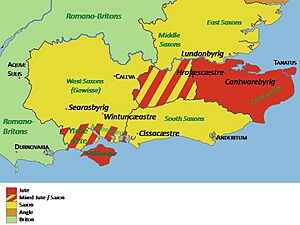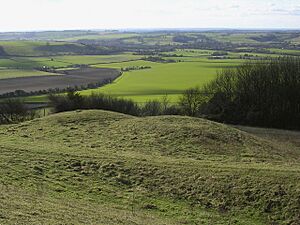Meonwara facts for kids
Quick facts for kids
Meonwara
|
|||||||||
|---|---|---|---|---|---|---|---|---|---|
| 5th century–7th century | |||||||||
| Common languages | Northwest Germanic Old English (Englisc) |
||||||||
| Religion | Paganism |
||||||||
| Government | Thing (assembly) | ||||||||
| History | |||||||||
|
• Established
|
5th century | ||||||||
|
• Disestablished
|
7th century | ||||||||
|
|||||||||
The Meonwara were an early Anglo-Saxon tribe in Britain. They lived in the Meon Valley in Hampshire, England. Their land became part of the powerful Kingdom of Wessex in the late 600s.
Contents
What Does "Meonwara" Mean?
In the 700s, a famous historian named Venerable Bede wrote about the people living in the River Meon valley. He called them Meonwara, which means "Meon People." He also called their area Provincia Meanwarorum, or "Province of the Meon People."
We aren't completely sure where the name "Meon" comes from. It might be an old Celtic word, or even older. Some think it means "swift one," possibly referring to the river.
Who Were the Anglo-Saxons?
After the Romans left Britain, new groups of people arrived from what is now Germany and Denmark. These groups were the Saxons, Angles, and Jutes. They are known as the Anglo-Saxons.
Bede wrote about these groups in his book, Ecclesiastical History of the English People. He said that the Jutes settled in Kent, the Isle of Wight, and also in parts of Hampshire. The Meonwara were likely one of these Jutish groups.
There is evidence that Jutes lived in the Meon Valley. For example, a large Jutish cemetery was found in Droxford, a village in the valley. Also, some local traditions were similar to those found in Kent, where many Jutes lived.
Stories from the Anglo-Saxon Chronicle
The Anglo-Saxon Chronicle is a collection of old English records. It tells stories about Anglo-Saxon settlers arriving between the years 449 and 514. It says that the Meonwara were founded by a man named Port and his two sons, Bieda and Maegla.
However, most historians think these stories are more like legends than true history. The names mentioned might not even be Germanic. For example, "Maegla" could be an old British word meaning "chief" or "prince."
The Rise of Wessex
The Kingdom of Wessex became very powerful. Its beginnings are a bit unclear. The Chronicle says that Cerdic of Wessex and his son Cynric of Wessex landed in Hampshire in 495. They supposedly founded the West Saxon kingdom.
But many historians doubt this story. They believe the early West Saxon kings ruled over a group called the Gewisse. Their main power was in the upper Thames Valley, further north.
Mercian Influence
To the north of the West Saxons were the Mercians, another strong Anglo-Saxon kingdom. In the 600s, Mercia was growing in power. This meant the West Saxons couldn't expand north. So, they looked south instead.
Around 681, Wulfhere of Mercia took control of southern Hampshire and the Isle of Wight. He then gave these lands, including Meonwara, to Æthelwealh of Sussex, the king of the South Saxons. This gift might have been after Æthelwealh became Christian and married a Mercian princess. This alliance put pressure on the West Saxons.
Wessex Takes Over
After Wulfhere's death, Mercian power weakened. The West Saxons, now known as the Kingdom of Wessex, became strong again under their king Caedwalla. He was worried about Mercian and South Saxon power in southern England.
In the late 680s, Caedwalla conquered the South Saxons and took over the Jutish areas in Hampshire and the Isle of Wight. Bede describes how Caedwalla was very harsh, replacing the people of the Isle of Wight with people from his own kingdom.
Caedwalla was quite young, but he gave up his throne soon after these battles. In 689, he went on a journey to Rome to be baptized. He died about a week after his baptism. Bede suggests he might have been wounded during the fighting on the Isle of Wight, which could have led to his early death.
After Wessex took control, a large trading town called Hamwic was built. This shows that controlling the Solent (the strait between the mainland and the Isle of Wight) was important for trade and power. The main church of Wessex, the church of SS Peter and Paul, also moved to Winchester in the 660s.
Other Settlers in the Area
The village of Exton, located on the west side of the River Meon, has a name that suggests influence from the East Saxons. The earliest record of the name, from 940, is East Seaxnatune, meaning "East Saxon's farm."
See also



